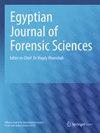使用碳点检测潜在指痕的综合综述
IF 1.3
Q3 MEDICINE, LEGAL
引用次数: 0
摘要
指痕是在犯罪现场发现的最古老、可靠和普遍接受的证据之一。它们可以用来将嫌疑人与犯罪现场和犯罪武器联系起来。指痕经常被用于调查刑事案件、识别失踪人员和罪犯。传统方法,如氰基丙烯酸酯熏蒸法、碘熏蒸法、茚三酮法、硝酸银法、小颗粒试剂法和粉末撒粉法,通常用于检测和显现各种重要法证表面上的潜在指痕。然而,这些方法存在一些局限性,包括对比度差、灵敏度低、背景干扰和特异性低。为了克服这些局限性,如今纳米粒子在潜伏指痕的发展中变得越来越重要。在本综述中,我们将重点介绍用于潜伏指痕开发的碳点(CD)纳米材料。碳点具有优异的荧光性能、颜色可调节性、低合成成本和无毒性。CD 的颜色和发光强度取决于其形态和合成方法。CD 可以固体或溶液形式用于在各种多孔和无孔表面形成潜指印。CD 有可能成为在各种多孔和无孔法医物品上提取潜在指印的理想选择。用 CD 制作的指纹具有极佳的对比度和分辨率。它们具有体积小、生物相容性好、合成简便且成本低廉、颜色可调等优点,可以成功地克服传统方法的局限性。本文章由计算机程序翻译,如有差异,请以英文原文为准。
A comprehensive review on the detection of latent fingermarks using carbon dots
Fingermarks are one of the oldest, reliable, and universally accepted evidence found on the crime scene. They can be used to link suspect with scene of crime and weapon of offence. Fingermarks are frequently used to investigate criminal cases and identify missing persons and criminals. Conventional methods such as cyanoacrylate fuming, iodine fuming, ninhydrin, silver nitrate, small particle reagent, and powder dusting are routinely used to detect and develop latent fingermarks on various surfaces of forensic importance. However, these methods suffer several limitations including poor contrast, low sensitivity, background interference, and low specificity. To overcome these limitations, nowadays, nanoparticles have gained importance in the development of latent fingermarks. In this review, we focus on the carbon dots (CD's) nanomaterial for the development of latent fingermarks. CD’s have superior fluorescence performance, color tuneability, and low synthesis cost and are non-toxic. The color and intensity of luminescence of CD's depend on its morphology and synthesis method. CD's can be used either in solid or solution form to develop latent fingermarks on the various porous and nonporous surfaces. CD’s are potentially a good candidate to develop latent fingermarks on wide range of porous and nonporous items of forensic importance. The fingerprints developed with CD’s show excellent contrast and resolution. Their small size, biocompatibility, facile and low-cost synthesis, and color tuneability can be successfully utilized to overcome the limitations of the conventional methods.
求助全文
通过发布文献求助,成功后即可免费获取论文全文。
去求助
来源期刊

Egyptian journal of forensic sciences
MEDICINE, LEGAL-
CiteScore
2.00
自引率
0.00%
发文量
51
审稿时长
17 weeks
期刊介绍:
Egyptian Journal of Forensic Sciences, the official publication of The International Association of Law and Forensic Sciences (IALFS), is an open access journal that publishes articles in the forensic sciences, pathology and clinical forensic medicine and its related specialities. The journal carries classic reviews, case studies, original research, hypotheses and learning points, offering critical analysis and scientific appraisal.
 求助内容:
求助内容: 应助结果提醒方式:
应助结果提醒方式:


